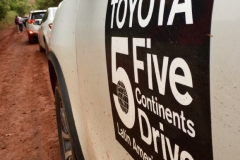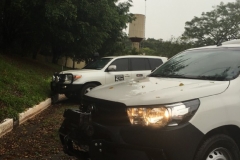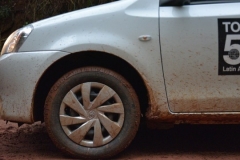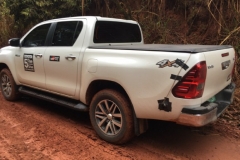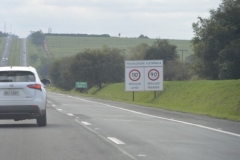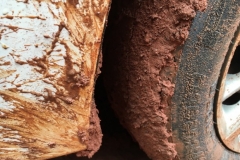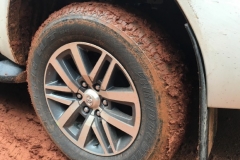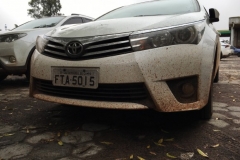Hattori from Legal Affairs joined the team in Ubatuba. He couldn’t help but ask Luiz from TDB, who was riding in the same car, if they were really driving on a highway. There were people waiting in the center median to cross the road and stray dogs walking along the shoulder. While technically a highway, the road had been built following the natural shape of the land and had almost no flat sections. The team members adapted their senses to Brazil little by little on the 400-km drive to São Pedro, braking sharply before speed cameras, following trucks that slow to a crawl on uphill slopes, and driving on straight roads that traverse hills and extend out to the horizon. The project team drove across Brazil in a caravan—an experience Japanese people would normally never get to have. Counting themselves lucky to get special permission for the project in this Olympic year, they gradually became acclimated to the highways of Brazil.
Driving on roads that defy imagination in a car he helped design.
Yamamoto, from the Chassis Design Division, was involved in designing the Etios Hatchback, a leading model in Brazil. He’d been to São Paulo once before, but it was his first time driving there. He looked excited as he got in the car that he had helped design to drive from São Pedro to São José do Rio Preto.
He drove away from the coast, heading toward Brazil’s border with Paraguay. It rained from the morning, and the red dust of the dirt road turned to mud. It was a Prius that got stuck in it. Just after changing drivers, a TDB7 member not used to the Prius’ low body swerved to avoid an oncoming car and got stuck in the mud. A Hilux wasted no time in pulling it out with its cable.
The road is a lifeline, and the team was reminded that passenger vehicles need to drive on it. The team had been worried that the Etios Hatchback wouldn’t have enough power, but it had no problem climbing the hills and driving through mud while carrying four adult men.
Even though they were told that the road conditions were not a problem, they still defied the Japanese imagination. Japanese people would never think to drive a passenger car on a muddy dirt road. If there’s a pothole on a paved street, Japanese people drive around it, but some Brazilians drive right over it. Can the suspension withstand this repeated stress? This is why Yamamoto says he’s in Brazil—to experience ways that people use their cars that go above and beyond what he imagines when he’s designing.
A long drive punctuated by avoiding potholes.
It was a long drive of more than 600 km to Campo Grande, which means “great field.” The roads changed once the team left São Paulo state and entered Mato Grosso state, presumably due to state finances. There were definitely more potholes, and what had been a straight road extending forever and a boring drive was now a road that forced drivers to stay on alert. The team arrived at Campo Grande an hour later than scheduled, and the sun was setting when they reached the city, which suddenly rose up from the road after a ranch by the name of Fazende.
At the debriefing, the team members gave their impressions of the cars and trucks. Slight vibration coming from the Corolla’s steering wheel was an issue, as was road noise in the Etios, although the Etios was very well balanced. Driving for long periods sharpens the senses and allows the body to store up these perceptions. Daniel, a TDB member who was on his last day of the project, expressed his gratitude for the opportunity the project gave him to experience the true Toyota Way of genchi genbutsu firsthand. He also encouraged team members to keep in touch and intended use the friendships he had made on the journey to make future cars. The TDB members take a lot of pride in Toyota.
Everyday scenes feel special.
Soon after leaving Campo Grande, the team hit dirt roads again. Umetsu from the Customer Quality Department, who had hardly ever driven on lengthy dirt roads, was surprised at the loss of visibility caused by the dry dust.
He quickly adjusted his distance from the car in front of him and started driving slow and steady, muttering, “I can’t see anything in front of me.”
He continued, “If you showed people in Japan a photo of this road, they’d assume it was somewhere special. But all this dust flying up in the air is really just from driving down one dirt road. And this road is a lifeline so to speak. To experience this firsthand is the reason I’m participating in the project.”
A bus appeared from out of the dust just after he said this. Hardly any houses were visible, but people around here must take this bus to commute to work and school. Nagayama from TDB, who was riding in the same RAV4, was familiar with the dirt roads around São Paulo but hadn’t driven almost anywhere else in Brazil. The Drive Project also gives TDB members a valuable chance to get to know their own country better. After getting back on the highway, the team reached Pantanal, a protected wetland area. They spotted a caiman about 50 cm long lurking in a pond near their hotel.
